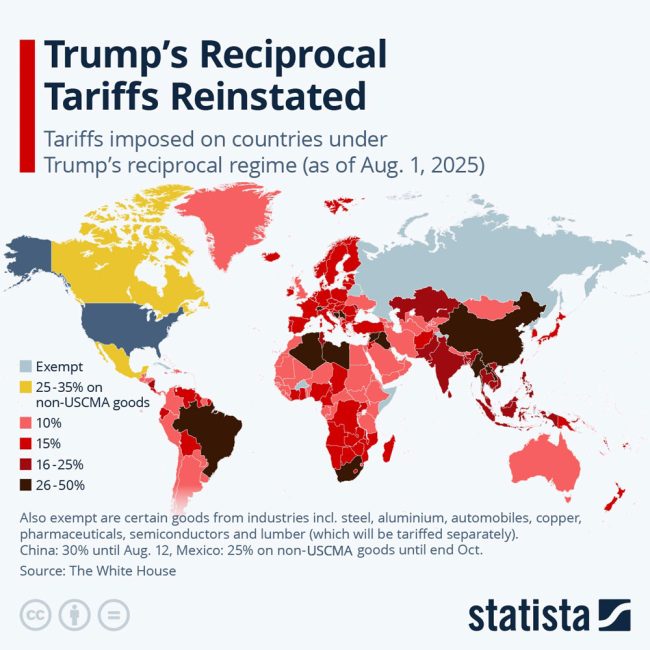
To include your event in the Briefing and Live Calendar, please fill out this form.
Weather: Showers and thunderstorms likely. Mostly sunny, with a high near 91. Chance of precipitation is 70%.
- Daily weather briefing from the National Weather Service in Jacksonville here.
- Drought conditions here. (What is the Keetch-Byram drought index?).
- Check today’s tides in Daytona Beach (a few minutes off from Flagler Beach) here.
- Tropical cyclone activity here, and even more details here.
Today at a Glance:
Ribbon-cutting: The City of Palm Coast marks the completion of the Wastewater Treatment Plant 2 expansion project at a ribbon-cutting ceremony at 8:30 a.m. at the facility, 400 Peavey Grade off US1. The ribbon cutting will include participation from Palm Coast City Council members and administration, project stakeholders, and members of the city’s Utility Department. It is open to the public.
The Flagler County Commission meets at 9 a.m. at the Government Services Building, 1769 E. Moody Boulevard, Building 2, Bunnell. Access meeting agendas and materials here. The five county commissioners and their email addresses are listed here. Meetings stream live on the Flagler County YouTube page.
The Beverly Beach Town Commission meets at 6 p.m. at the meeting hall building behind the Town Hall, 2735 North Oceanshore Boulevard (State Road A1A) in Beverly Beach. See meeting announcements here.
Notably: The geopolitical bigotry and economic suicide of tariffs in color. From Statista: “The Trump administration on Thursday announced that a week from now, so-called reciprocal tariffs of between 15 and 50 percent on countries around the world will be back in effect, as a 10-percent tariff rate on most of the rest of the world will stay in place. Trump had introduced the tariffs on April 2 but paused all but the 10-percent worldwide rate almost immediately for 90 days. After some rates were adjusted in early July, Trump last night once again made changes. Seven trade deals or outlines with the EU, the United Kingdom and Asian countries reached in the past months also changed tariff rates for the nations affected. Overall, tariffs don’t reach as high now as when they were first announced. The exception is Brazil, where a tariff of 50 percent is now imposed as Trump is trying to threaten the country to stop prosecuting former President Jair Bolsonaro, a Trump ally. The highest rate otherwise is 41 percent on Syria, followed by Laos, Myanmar and Switzerland. Canada was hit with 35 percent on goods not covered by the United States-Mexico-Canada trade agreement, while Mexico has another 90 days to negotiate and prevent a rate higher than the current 25 percent on good not under the trade deal. But the two U.S. neighbors are not the only nations with some exceptions. The EU, now subject to a tariff rate of 15 percent, is estimated to be paying the duty on around 70 percent of its goods exported to the U.S. due to exceptions, which other countries also have. Some goods are generally exempt from Trump’s reciprocal tariffs, but they are already (or are planned to be) tariffed separately.”
![]()
The Live Calendar is a compendium of local and regional political, civic and cultural events. You can input your own calendar events directly onto the site as you wish them to appear (pending approval of course). To include your event in the Live Calendar, please fill out this form.
December 2025
Flagler Beach United Methodist Church Food Pantry
Flagler County Drug Court Convenes
Model Yacht Club Races at the Pond in Palm Coast’s Town Center
Palm Coast Democratic Club Meeting
Flagler Beach City Commission Meeting
Rotary’s Fantasy Lights Festival in Palm Coast’s Town Center
Evenings at Whitney Lecture Series
‘Annie,’ at Limelight Theatre
Irving Berlin’s Holiday Inn
‘Greetings,’ A Christmas Comedy
Free For All Fridays With Host David Ayres on WNZF
Friday Blue Forum
Rotary’s Fantasy Lights Festival in Palm Coast’s Town Center
The Bronx Wanderers at the Fitzgerald Performing Arts Center
‘Annie,’ at Limelight Theatre
For the full calendar, go here.

The phrase “New South” may be the most overused and meaningless regional designation on the American landscape. When introduced during the 1880s by the Atlanta newspaper editor and regional promoter Henry Grady, it denoted a South eager to move on after the Civil War, a South that was seeking Northern investment and capital by offering up a let-bygones-be-bygones view of the “late unpleasantness” in the interest of economic progress. Grady’s vision was based on the idea that Southerners would gladly provide cheap labor for Northern capitalists as long as the Yankees would pretty much let the South do what it wanted about race, a deal that turned out to be just fine with the North. Over time, the term has come to be used as an all-purpose, slightly condescending designation of approval, denoting a South where people don’t go barefoot, don’t join the Klan, don’t go around lynching people. It’s enough of an empty cliché that the novelist Walker Percy once groused, “My definition of a new South would be a South in which it never occurred to anybody to mention the New South.”
–From Peter Applebome, Dixie Rising (1996).











































Pogo says
@Dear God
… have pity:
The Waltons Get Rich While Other Billionaires Get Poorer
Story by Douglas A. McIntyre
https://www.msn.com/en-us/money/companies/the-waltons-get-rich-while-other-billionaires-get-poorer/ar-AA1JSwQz?ocid=nl_article_link&cvid=28b5a77106b64a7093c1ef6889a80397&ei=18
Thoughts and prayers.
Pogo says
@Ragged Dick
… makes good (and a lot a cheddar):
Tesla just announced a $29 billion pay package for Elon Musk, saying ‘no one matches’ the CEO
Story by [email protected] (Tom Carter)
https://www.msn.com/en-us/money/companies/tesla-just-announced-a-new-29-billion-pay-package-for-elon-musk/ar-AA1JRK4l?ocid=nl_article_link
People actually earn a living saying, and writing such, and its like.
For reference:
Legend of fiction honored as history by the current regime and its progenitors
https://en.wikipedia.org/wiki/Ragged_Dick
Ray W, says
According to AUTOPOST, China’s Li Auto just released its Tesla Y-class SUV entry, the i8 battery electric vehicle (BEV).
Here are some bullet points from the article:
– The SUV’s dual electric motors produce 536 bhp, capable of a 0-62 acceleration time of 4.5 seconds.
– The entry-level SUV has a 90.1 kWh liquid-state lithium-ion battery, known as a NMC-style (nickel, manganese, cobalt) battery, with a range of 416 miles, using the Chinese measuring standard.
– A battery upgrade to 97.8 kWh of capacity is available, with a 447-mile estimated range. This version is “ultra-fast charging” capable, and it adds 310 miles of range in 10 minutes.
Starting price? $44,691, less that Tesla’s Model Y in the Chinese marketplace.
Make of this what you will.
Ray W, says
This coming Friday, according to the Detroit Free Press and other publications, Ford’s CEO, Jim Farley, is slated to announce Ford’s near- and long-term plans. It is being touted as Ford’s next “Model T Moment.”
Ray W, says
Per The Street, during Ford’s second-quarter earnings call, CEO Jim Farley stated that tariffs are going to impact Ford’s business by $2 billion in 2025.
Here are more bullet points from the article:
– Ford imports 23% of its units from abroad, less that GM’s greater than 50% import ratio. Stellantis (Chrysler’s import ratio resembles GMs.)
– Every OEM (original equipment manufacturer) company requires imported parts and components, so tariff costs will impact everyone.
– GM holds a 17% share of the American marketplace, followed by Toyota (15%), Ford (13%), Hyundai (11%) and Honda (9%).
– Mr. Farley says that “[w]e increasingly see Europe, North America, and Asia becoming a kind of regional businesses with trade tariffs that are aligned for those three or four regions. And I believe that is a long-term challenge. … And the regions will pick them. So I believe this is quite a fundamental change.”
– Ford’s position is that it is time to renegotiate the USMCA North American trade deal, as current tariff rates are not high enough to force a “major” change in American automobile manufacturing.
Make of this what you will.
Ray W, says
The Washington Post devoted an article to last Thursday’s Commerce Department release of the year-over-year personal consumption expenditure price index data, which is the preferred inflation gauge relied on by the Fed.
For the 12 months ending in June 2025, consumer prices rose by 2.6%. The “core” measure that strips out the more volatile food and fuel sectors saw consumer prices rise by 2.8% year-over-year.
Readings for the April and May data were revised upwards, too.
Consumer spending grew month over month, but more slowly than analysts expected.
According to the Post, data published by the Bank of America Institute shows that spending on services, such as hotels and restaurants has dropped each of the past three months, and that credit card spending increased last month, but the increase was less than the total decline in credit card spending in April and May.
The head of Bank of America Institute, Liz Everett Krisberg, told reporters:
“If you were to say, ‘What is the temperature of the consumer right now?’ I would say it’s cooling but it’s not frozen. It’s not collapsing.”
The Post reporter ended the column:
“Though the Fed held interest rates steady this week, officials were not united in the decision. Two members of the central bank’s board of governors dissented, signaling they would have preferred a rate cut — though not nearly as steep as the cuts Trump has called for. Still, the split underscored growing debate within the Fed over how to respond to a murky economic outlook.”
Make of this what you will.
Me?
The fact that two board of governors preferred a lending rate cut is important, but that is still only two of seven board of governors voting members and two of the overall twelve FOMC voting members.
I agree with the language used by the Post reporter that the economic outlook remains “murky”. Fed Chair Powell has repeatedly stated that until the American economic outlook clears, it is better to wait before responding up or down, re: lending rates.
Nonetheless, late last year the year-over-year inflation rate had dropped to 2.2%. The Fed began dropping the lending rate. Then, the inflation rate ticked up to 2.3% and then again to 2.4%. The Fed stopped lowering the lending rate. In the past three or four months, the inflation rate, year-over-year has been ticking ever higher. The Fed is waiting for the murkiness to clear.
More than three years ago, the Fed announced that its primary goal would be to drive inflation down toward 2.0%, even if that primary goal damaged the strength of the labor market. Slowly but steadily, the inflation rate dropped. But the labor market showed little sign of slowing down. Finally comes a report that the labor market is slowing and has been slowing for several months. That supports an argument to cut lending rates. But the inflation rate is rising. The supports an argument to raise lending rates.
As an aside, it is being reported that the daughter of a South Korean Episcopal priest, both mother and daughter being in the country on special visas, and an honors student at Purdue University, was detained by ICE officials after she attended a hearing on her visa status.
According to a CNN article, the daughter’s visa expires in December, 2025. She was attending the hearing in order to ask for and hopefully obtain from the hearing officer an extension of her still valid visa.
ICE officials told reporters that the daughter’s visa expired two years ago.
She has since been released from detention.
Story after story, instance after instance, ICE officials seem to be working hard at establishing a significant body of lies whenever anyone challenges their seizures of individuals. More and more, they seem unable to tell the truth.
There is a sickness upon the land. More and more people seem compelled to launder lies as if laundering lies is a virtuous act. Many FlaglerLive commenters deceive themselves into believing that they hold the political power to determine illegality for other people. They do not hold such a power, nor have they ever held such a power, so anything they say on that subject is simply them talking to hear their heads roar.
Such commenters are presuming other people to be in violation of the law. Such a presumption of guilt does not exist anywhere under any form of American law.
Our founding fathers gave the political power to determine the violation of the laws to the courts and to administrative hearing officers, where appropriate.
A person is not illegal until a court, be it an administrative hearing officer or judge, determines that person to be illegal.
Every traffic ticket issued by a law enforcement officer is nothing more than an allegation of a violation of a traffic law, not a final determination of a violation of a traffic law. Police officers simply lack the power to do anything more than allege a violation. Any allegation contained in a traffic ticket cannot become final until a hearing magistrate or a judge finds the driver to have been in violation of the traffic law at issue, with the exception of those who elect to pay the ticket or attend a traffic class in lieu of attending court.
Ray W, says
In what I consider one of the better and well-balanced written stories about the manifold and competing economic situations faced by the today’s Fed, a Wall Street Journal reporter, Nick Tiramaos, wrote:
“Setting interest rates is sometimes more than an art than science, especially when the economy keeps defying predictions — a reality the Federal Reserve confronted head-on Wednesday.
“There are two economic worlds the U.S. could be living in right now, and Fed officials might not know which one for months. In one, economic weakness that’s been lurking beneath reasonably solid headline numbers finally surfaces. In the other, artificial intelligence investment and buoyant household wealth power the economy past trade-war headwinds.
“The Fed held rates steady this week, and Fed Chair Jerome Powell kept his options wide open for its next gathering in September, promising little while ruling out nothing.
“Officials are betting they can afford to wait at least two months for clarity on whether tariffs will slow economic activity, fuel inflation, or pass by with little effect. That patience comes with risk — on both sides.
“Powell suggested he was still committed to preserving the soft landing it looked like the economy had achieved at the beginning of the year, in which inflation had declined without significant damage to the labor market. By pushing up prices of some goods, tariffs have since created crosswinds that could blow the Fed off course.
“The Fed provided extraordinary stimulus when the Covid-19 pandemic hit five years ago and was slow to withdraw it, leading to a blitz of rate hikes in 2022 when inflation proved more stubborn.
“On Wednesday, the Fed chair repeated the pledge he made four years ago to make sure any price increases wouldn’t persist.
“‘We want to do that efficiently, though — efficiently,’ he said at a news conference. Cutting rates too soon could force the Fed to come back later and raise them. ‘That’s inefficient,’ Powell said. But waiting too long could cause unnecessary damage to the labor market.
“In one economic world, the low and stable unemployment rate that Powell touted as a sign of economic stability is masking gradual labor market deterioration that could accelerate quickly.
“‘The unemployment rate being at 4.1% gives you a false sense of what’s actually going on in the job market,’ said Neil Dutta, head of economic research at Renaissance Macro Research.
“More people are out of the workforce who actually want jobs than is typical for an economy with such a low unemployment rate, said Dutta. An unusually high number of workers are seeing no wage growth, and barely half of industries have been adding jobs — a historically weak reading. Fed governor Christopher Waller flagged such concerns in a speech two weeks ago.
“A world where the labor market is starting to come undone will validate Powell’s critics who say the Fed should have resumed cutting this week, if not earlier this year. Waller, who dissented from the Fed’s decision Wednesday because he favored a rate cut, has argued that the economy isn’t as strong as it might seem.
“Powell didn’t dismiss those fears on Wednesday. The unemployment rate has stabilized because both the supply of workers and the demand for labor is falling at roughly the same pace. That’s one reason ‘we do see downside risk in the labor market,’ he said.
“Pockets of weakness are also showing up in consumer spending. …
“Consumers are pulling back on discretionary categories like travel and dining even as nondiscretionary costs like insurance and rent continue climbing. …
“Housing markets represent another source of economic drag that could amplify labor market weakness. Residential investment has been declining and inventories of for-sale housing are growing, a sign that more housing markets are exhausting the universe of buyers willing or able to purchase homes with mortgage rates above 6.5%.
“But there’s a competing view that sees these warning signals as noise rather than signal. In the second world, the economy’s track record of defying predictions continues, powered by forces that could override the emerging weakness.
“The economy has motored through a swift run-up in interest rates in 2022, a regional banking crisis in 2023, and now trade disruptions in 2025, said Ajay Rajadhyaksha, global chairman of research at Barclays.
“Rajadhyaksha highlights two key factors sustaining the economy: a boom in AI investment that has offset weakness in rate-sensitive sectors, and a considerable wealth buildup from higher home prices and stock portfolios that could support consumer spending by the well-off. …
“Absent some unforeseen shock such as a swift jump in long-term government-debt yields, ‘I have a very hard time seeing an outright recession in the United States,’ Rajadhyaksha said.
“In this state of the world, the Fed would have little reason to cut this year, said Michael Gapen, chief economist at Morgan Stanley. Even if tariff-related price hikes prove temporary, as Waller expects, they could set up a problematic sequence if, for example, Republicans’ tax cuts or potential consumer rebates boost spending.
“‘It’s not the tariffs that create the story of persistence; it’s the demand side that feeds off that tariff story,’ Gapen said.
“Rajadhyaksha thinks higher prices from tariffs will be a one-off, but he thinks the Fed will be hard-pressed to cut in September because those price increases will show up in the July and August inflation reports due beforehand.
“Claudio Irigoyen, a former central banker in Argentina who now heads global economic research at Bank of America, called it risky to assume the answers to any tariff shock could be resolved in a matter of months.
“‘The pandemic was also a temporary shock that the Fed decided to look through, and they were wrong,’ he said. ‘Not because it wasn’t temporary, but because temporary means a year and a half or two — long enough for you not to ignore it. …”
Make of this what you will.
Me?
A $30 trillion economy built largely on the spending habits of 340 million Americans is far too complex for any one economic model to simplify. There are too many competing visions. No one has seen tariff increases like the ones coming down the pike in 90 years. Economic models are built looking backwards at mountains of data.
The phrase that “temporary” means 18 months or two years resonates with my way of thinking. We are six months into a tariff experiment. Ed P. might be right. President Trump might be playing chess while the rest are playing checkers. Then again, he might be playing with fire with no fire station for miles and miles and miles.
Sherry says
For those horrific, inhumane people that are “tired of hearing about children starving in Gaza” :
Silence in the Face of Gaza’s Starvation is Absolute Betrayal of Holocaust Victims
By Orit Kamir
In her childhood, my mother was starved by a dark regime. When the Nazi army occupied Poland and Jews were pushed into ghettos, they were forced to make do with less and less food. Eventually, food disappeared almost entirely. My mother was seven years old when the Lvov ghetto closed in on her. Fortunately, both her parents were alive and did everything to ensure her survival. The nutrition they managed to obtain for her was very meager: lengthy searches in the streets and trash cans sometimes yielded potato peels or edible plants. My grandmother would cook them and the water was drunk as soup. Proteins, sourced from various insects, were rare. Nevertheless, my mother was lucky. Other children wasted away and died.
The Nazi regime reduced the ghetto’s boundaries and squeezed its residents, whose numbers dwindled daily, into increasingly smaller areas. My mother and her parents found themselves sharing an apartment with a family named Mintzer, consisting of two parents and four children. Both parents and the eldest son were captured in aktions and sent to extermination. Another son, hungry and weak, fell ill and languished for many days until he breathed his last. My grandparents tried to revive the two orphaned children who remained, but they couldn’t help: they had nothing to give. The entire Mintzer family was annihilated. Bella, the youngest daughter, was ten years old when she died.
My mother somehow survived the starvation and the war, but the Mintzer children who wasted away before her eyes remained with her always. They accompany me to this day. The survivors’ guilt doesn’t dissipate and the scar still burns. On my first visit to Lvov, I searched for that building in the ghetto and lit memorial candles for them. Who would have believed that eighty years after they were starved to death, my country, the Jewish state, would decree that I bear real guilt for the starvation and extermination of tens of thousands of children like them. The state that arose from the ruins of that destruction has brought a hundred thousand children in Gaza to the danger of death from starvation.
Whether our mother was there in body or not – we are all second, third, and fourth generation to victims of starvation and extermination. And the one commandment the victims left us, all of us, is simple: never again. Because every person, as a human being, has absolute and inviolable value, “human dignity,” and our supreme duty is to recognize and ensure it. Simply because they are human. All the more so for children. They are always entitled to life, to protection, without question and without qualification. This is the entire Torah and there is nothing else. And it dictates our responsibility and our moral duty.
But in 2025, the Israeli army, on orders from the political echelon, is destroying Gaza and exterminating its population. Neighborhood after neighborhood and city after city in the Strip are destroyed to the foundations, and people are expelled with nothing and pushed to crowd into increasingly smaller areas. Like then. After we destroyed all infrastructure, including hospitals, the mortality is relentless. Families constantly shrink and thousands have already been erased from the face of the earth. Others leave behind hopeless orphans, abandoned to their fate. Like then.
Since Israel broke the ceasefire in March, Gaza’s besieged population has also been deliberately and systematically starved. Israel allows only very little food to enter the Strip, and what little is allowed in is brought in a way that cannot reach all residents. Children, the sick, the elderly, people weakened by hunger – cannot reach the four food distribution stations Israel created, instead of the 400 stations that operated before. We have decreed their fate to languish until they die of hunger, weakness, and disease. Relatively strong young people who do reach the distribution stations to get some relief are shot to death daily by Israeli soldiers.
There is no electricity, no gas, no clean water; if someone finds a potato peel – there isn’t even a way to cook it. And all this time, Israel prevents the entry of food, medicine, and other vital supplies that could save lives, and which are available in large quantities at hand (because they are held by UN organizations that Israel decided to boycott), and denies its actions – even now, as it tries to make minor corrections at the margins.
This is conduct of incomprehensible cruelty. It creates horror beyond the ability to imagine, and this allows most Israelis to deny it: if it’s too terrible to be true – it’s probably not true. And so they allow the horror to continue happening.
What value does our freedom have if we don’t use it to stop dispossession, killing, and starvation? What do we need the rule of law for if not to ensure human dignity?
The Israeli public’s silence is a betrayal not only of the entire world of values it claims to hold; it is an absolute betrayal of Holocaust victims, in whose name we demanded a state for ourselves where we could ensure our existence. It is a betrayal of the Mintzer family and the millions of other families who were slaughtered and perished throughout Jewish history. It is a betrayal of the entire long legacy of Jewish existence as a persecuted minority. It is a betrayal of humanity in general – and of our collective identity in particular. It is such a monumental betrayal that it’s hard to contain.
I don’t usually invoke the name of the Holocaust, because too many bear it in vain, but now it’s unavoidable.
Those who rejoice in Gaza’s destruction and annihilation, those who justify or rationalize the horror with talk of revenge for the terrible massacre of October 7 – have lost their souls. But those who can still feel human emotion must wake from the paralyzing slumber and shake off this unforgivable betrayal.
You who cry out against the firing of the Shin Bet chief and the attorney general and the chairman of the Foreign Affairs and Defense Committee – but fill your mouths with water regarding the extermination and starvation we are carrying out in Gaza: your concern for Israeli democracy and the future of the state pales against your silence in the face of mass extermination. What value does our freedom have, which you fight for, if we don’t use it to stop dispossession, killing, and starvation? What do we need the rule of law for if not to ensure human dignity?
You who organize rallies to bring back the hostages, whom the government wickedly abandons with unbearable evil – but don’t address the destruction of the lives of another two million women and men who are also languishing in Gaza alongside the hostages: what kind of human solidarity is this, that applies only to the twenty “our” hostages, and closes its eyes to the fate of millions?
You who run WhatsApp groups with many participants and broadcast hope for a healthier and saner future – and close your eyes to the unforgivable crime: what rosy future can there be here, when the tens of thousands of children who died through our fault will accompany us wherever we go?
And you who presume to lead, in various ways, the sane public – but are careful not to say “controversial” things that might upset someone: shame on you. If children dying of hunger don’t disturb you enough to cry out without political calculations, what alternative are you offering? What leadership?
Where are the Holocaust researchers from Yad Vashem? The Medical Association? The nurses? Professional associations – of psychologists, sociologists, lawyers, social workers? Where are the student organizations? When children become Muselmänner and die in agony because of us – don’t you think it’s your duty to cry out until the horror stops? So what are you here for?
If a million Israeli women and men took to the streets, as one person, with an uncompromising demand to end the war immediately – this horror would end. Even a monstrous and disconnected government cannot ignore the entire public. When a million Israelis took to the streets, the hostages will finally be returned to their homes; the lives of soldiers, 896 of whom have already been sacrificed, will be saved; their souls will be saved from the insane trauma their state imposes on them; and two million people in Gaza will be rescued from the inferno Israel has trapped them in.
Pogo says
@Ray W
Pigs might fly too; the fire station was eliminated by cost cutting, the volunteers who manned it (God, I pray She forgive me my patriarchal imperialistic linguistic micro aggression) fail to heed the call: they’ve been evicted by banks and landlords, their ride to the erstwhile fire station repossessed, is out of fuel, or is the former firefighter’s home — or all three. And other things are going equally well.
A million dollars used to seem like a lot of money.
Ray W, says
Hello Pogo.
This from Martin Gilbert’s 8-volume (the first two volumes of which being written by Randolph Churchill before his death) biography of Winston Churchill:
“During one dinner at the Chateau Verchocq, Churchill began to recite, from memory, several of the war poems of Siegfried Sassoon. This was something he did quite often. On August 10 [1918] Lord Esher had written to Philip Sassoon: ‘By the way, who is Siegfried Sassoon. … Winston knows his last volume of poems by heart, and rolls them out on every possible occasion.’ Lieutenant Hall recalled a recitation at the Chateau:
“‘We all listened attentively. I had never heard of Sassoon or his poems and we were soon told something of this man’s history. It was obvious that the Minister held the greatest admiration for Sassoon as a man, as a soldier and as a poet. We quickly realised that the main theme of the poems was anti-war, the futility of war and the misery war brought. We heard that the Generals were seriously worried at the damage to morale these poems might inflict on the troops, and that it would be preferable for Sassoon to remain in England out of harm’s way. Mr Churchill then stated that on our return to England he intended to get in touch with Sassoon and to make some amends to him, possibly I believe by offering him a job in the Ministry of Munitions. I feel sure it was Winston’s brother who thereupon exclaimed ‘I should leave that man alone if I were you. He might start writing a poem about you,’ to which Mr Churchill immediately replied ‘I am not a bit afraid of Seigfreid Sassoon. That man can think. I am afraid only of people who cannot think.'”
Make of this what you will.
Pogo says
@Ray W
This, delayed due to time and attention given to my own imminent cataract surgery, and the latency of this mode — anyway, yes, damn right, and well said. Moreover, boy, oh boy — we have many, and much, to fear.